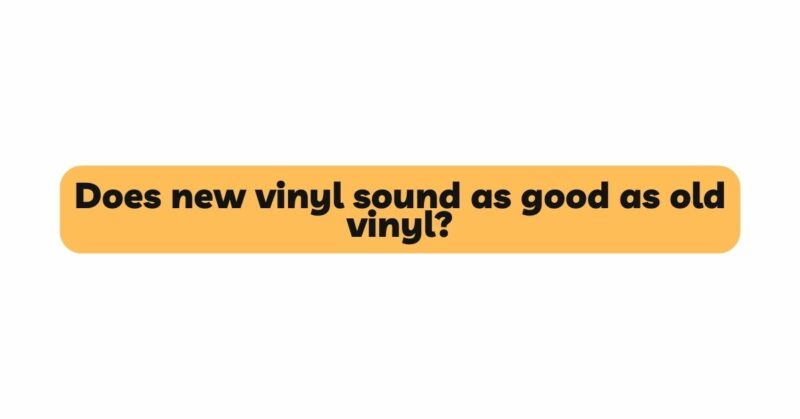The revival of vinyl records in recent years has sparked a passionate debate among audiophiles and music enthusiasts alike: Does new vinyl sound as good as old vinyl? While digital music has dominated the market for the past few decades, vinyl records have made a significant resurgence, capturing the hearts of a new generation and rekindling nostalgia for those who remember the analog era. This article delves into the various factors that contribute to the distinct sonic characteristics of old and new vinyl, exploring the arguments on both sides of the spectrum.
Historical Context
Vinyl records have been a staple of music consumption since the early 20th century, gaining immense popularity during the mid-20th century. The warm, analog sound produced by vinyl records became synonymous with the music experience of the time. However, with the advent of digital technology, compact discs and later digital downloads took over the market, offering unparalleled convenience but often sacrificing the warmth and depth that vinyl enthusiasts cherished.
Resurgence of Vinyl
In the 21st century, a renewed interest in vinyl records began to emerge. This resurgence was driven by a desire for a more tangible and immersive music experience, as well as a fascination with the tactile nature of vinyl. As a result, vinyl records started to be produced anew, not only by established artists reissuing their classic albums but also by new and independent musicians embracing the format. Record labels and pressing plants saw a resurgence in demand, leading to the rise of the modern vinyl industry.
The Sound of Old Vinyl
Proponents of old vinyl often argue that the vintage records possess a unique charm that newer vinyl releases may struggle to replicate. One of the defining characteristics of old vinyl is its inherent warmth and analog depth. Vinyl records produce sound by physically etching grooves onto the surface, and these grooves translate into a warm, organic sound that audiophiles find captivating. The process of pressing vinyl records in the past involved different materials and techniques, which some claim contribute to the distinct sonic signature of vintage vinyl.
The Age Factor
One of the critical factors influencing the sonic qualities of old vinyl is age. Over time, vinyl records can develop imperfections and wear due to repeated play, exposure to dust, and environmental conditions. These imperfections, often referred to as “surface noise,” become part of the listening experience for many enthusiasts, adding a unique character to each playback. Some argue that these imperfections contribute to the charm and authenticity of vintage records, making them an irreplaceable experience.
The Sound of New Vinyl
While the allure of old vinyl is undeniable, advocates for new vinyl releases argue that advancements in technology have led to improvements in the pressing process and material quality. Modern vinyl records are often manufactured with greater precision and quality control, leading to reduced surface noise and improved audio fidelity. Additionally, new vinyl releases benefit from the digital remastering techniques that can enhance the overall sound quality while preserving the original intent of the recording.
Quality Control and Consistency
Manufacturers of new vinyl records have taken steps to address the inconsistencies that were occasionally present in older pressings. New pressing plants are equipped with advanced machinery that allows for tighter quality control and more consistent results. This has led to a reduction in the variation between different copies of the same album, ensuring that listeners can enjoy a more faithful representation of the music.
The Digital Dilemma
An intriguing aspect of the vinyl debate lies in the influence of digital technology. Many contemporary music productions are digitally recorded, mixed, and mastered before being transferred to vinyl. Critics argue that this digital-to-analog conversion process can potentially negate some of the analog warmth that vinyl enthusiasts seek. However, proponents of new vinyl point out that when handled with care and expertise, the digital-to-vinyl transition can retain much of the desirable qualities of both formats.
Subjectivity in Sound Perception
It’s important to acknowledge the subjective nature of sound perception. What one listener might interpret as a flaw or imperfection, another might view as a distinct and charming element. Personal preferences play a significant role in how individuals perceive the sonic qualities of vinyl records. Some listeners might prioritize a pristine, noise-free listening experience, while others find the inherent quirks of vinyl to be an integral part of the appeal.
Conclusion
The debate over whether new vinyl sounds as good as old vinyl is far from settled. Both sides of the argument present compelling points, and much of the answer lies in personal preference. Old vinyl offers a nostalgic and authentic experience, complete with the imperfections that come with age. New vinyl, on the other hand, benefits from advancements in technology and quality control, offering a more consistent and refined listening experience. Ultimately, the magic of vinyl lies not only in its sound quality but also in the ritualistic experience of carefully placing the needle on the grooves and immersing oneself in the music. Whether old or new, vinyl records continue to captivate the hearts and ears of music enthusiasts, bridging the gap between the analog past and the digital present.


